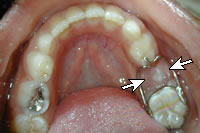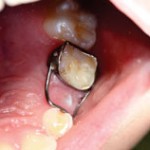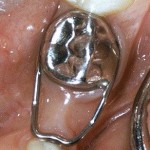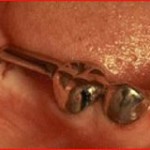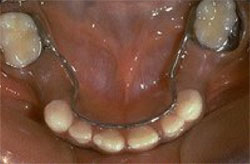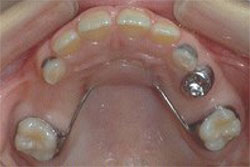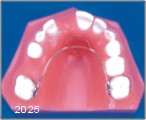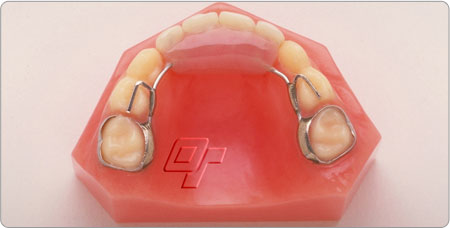Â
Â
Space Maintainer is a fixed or removable appliance designed to preserve the space created by the premature loss of a tooth (can be primary or permanent tooth). Fixed Space Maintainer is not intended to be removed by the patient whereas Removable Space Maintainer is designed for easy removal for cleansing and/or adjustment.
Â
Why do we use Space Maintainer?
Â
Basically, Space Maintainer is a form of preventive management for the developing occlusion (dentition) in children so that braces treatment will be less involved in the future. It is use to maintain spaces after a premature loss of primary teeth which shows signs of closing.Â
As our occlusion develops from the primary teeth through the transitional (or mixed) teeth to the permanent teeth, a sequence of events occurs in an orderly and timely fashion. These events result in a functional, esthetic and stable occlusion. When this sequence is disrupted, problems arise that may affect the final occlusal status of the permanent teeth. Once such disruptions occur, appropriate corrective measures for example, braces and orthopedic appliances; are needed to restore the normal process of occlusal development.
Having said that, the best space maintainer is the primary tooth itself. However, when the natural maintainers are lost, you should seek a dentist as early as possible for advice.
Failure to maintain space may result in the following:
– Drifting or tipping of teeth
– Crowding of permanent teeth
– Midline shift
– Loss of arch length
– Impactions
– Orthodontic intervention including serial extraction
Space Maintainers are not needed when:
1. If the succedaneous permanent tooth crown clinically visible
2. When there is general lack of sufficient arch length and where space maintainer would further complicate existing malocclusion
3. When succedaneous tooth is absent
Â
Here are some examples of Space Maintainers
- Â Â Â Â Â Â Â Â Band and Loop
- Â Â Â Â Â Â Â Â Crown and Loop
- Â Â Â Â Â Â Â Â Lingual Arch
- Â Â Â Â Â Â Â Â Palatal Arches:Â -Nance Palatal Holding Arch
                                                    -Transpalatal Arch
- Â Â Â Â Â Â Â Â Distal Shoe Appliance
- Â Â Â Â Â Â Â Â Fixed Appliances for Anterior Space Maintenance
- Â Â Â Â Â Â Â Â Bonded Space Maintainers
Band and Loop
Â
This appliance is easy and economical to make. It takes little chair side time for the dentist and patient, and it adjusts easily to accommodate the changing dentition. It is very effective for unilateral loss of single tooth in one arch. However, it does not restore chewing function and will not prevent the continued eruption of the opposing teeth; these may or may not be important factors depending on the case requirements.
Â
Crown and Loop
Â
This appliance has a Stainless Steel crown and loop maintainer which is used if the posterior adjacent tooth has extensive caries and requires a crown restoration or if the adjacent tooth had root canal treatment, in which it is desirable to protect the crown with full coverage.
Â
Distal Shoe Appliance
This is indicated when second primary molar is extracted or lost before the eruption of first permanent molar. This is a modification of a band and loop but in an opposite direction. Nevertheless, it is not recommended for children with very poor oral hygiene, congenitally missing first permanent molars or medically compromised patients.
Â
Lingual Arch
Â
Instances of bilateral single or multiple tooth loss in the lower jaw are suitable for this appliance. However, it is not recommended when the primary incisors are still present. Although it does not restore chewing function, the appliance has many advantages that outweigh this fact such as problem of patient cooperation and breakage or retention is eliminated.
Â
Nance Palatal Holding Arch
Â
This appliance is use to maintain the upper first permanent molars in placed when there is bilateral premature loss of primary teeth or it is combined with a habit breaking appliance by incorporating spurs in the acrylic button.
Â
Transpalatal Arch Appliance
Â
This appliance is indicated when one side of the arch is intact and several primary teeth on the other sides are missing. It serves several functions including correction of molar rotation, molar stabilization and anchorage, molar distalization (moving backwards)Â as well as other molar movements.
Â
Anterior Space Maintainers with Partial Dentures
Acrylic Partial Dentures are constructed to replace primary or permanent incisor area for young children, given that they are compliance, show interest and able to cooperate. Depending on cases, it can be a removable or fixed appliance. Replacing incisors are important to reproduce a desirable esthetic appearance, to reestablish function or to prevent abnormal speech and tongue habits. The problems with this type of replacement would be appliances are weak, required close monitoring; frequent alterations as dentition changes with time and the appliance may enhance caries risk.
Â
Â
Â
Â
